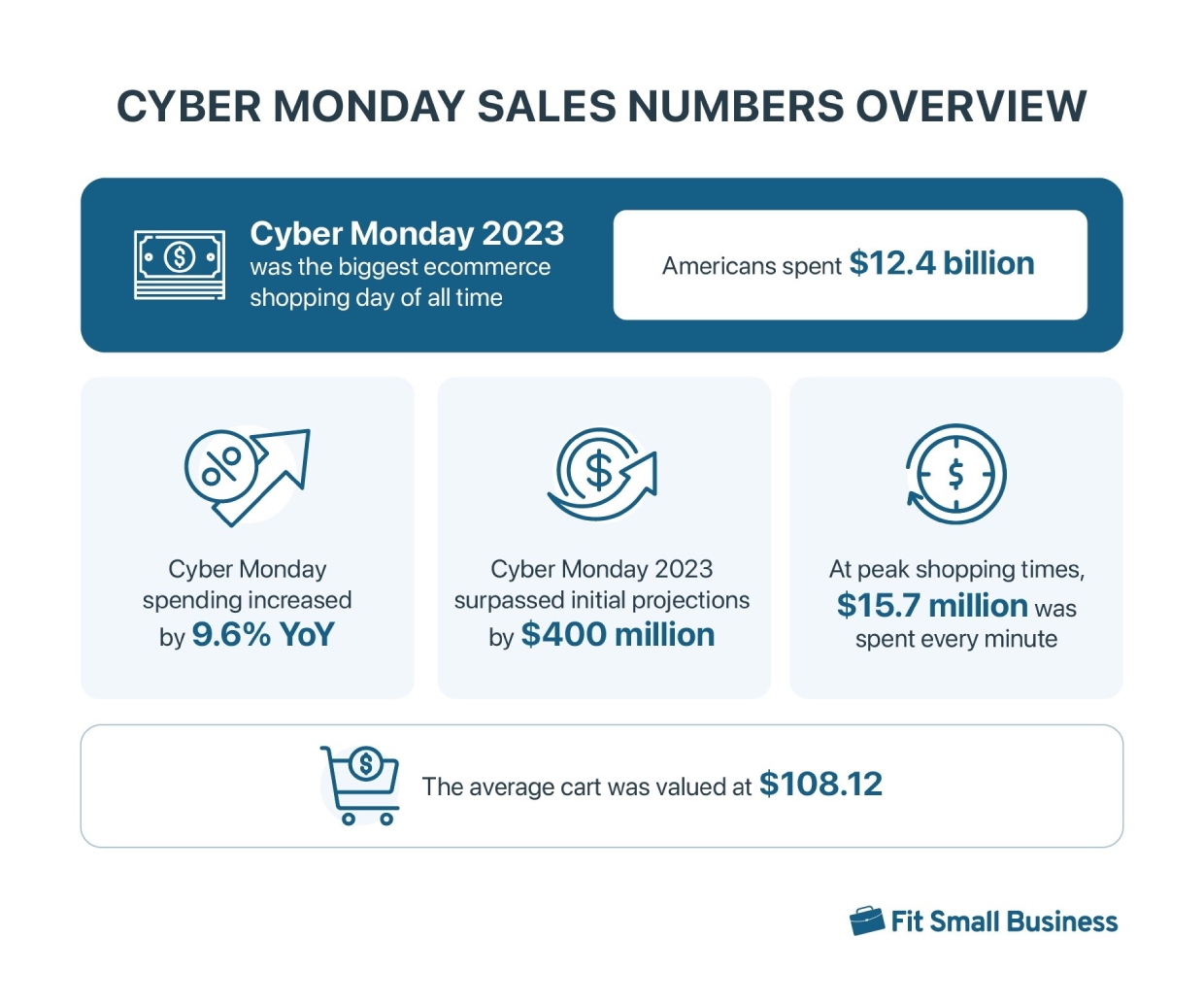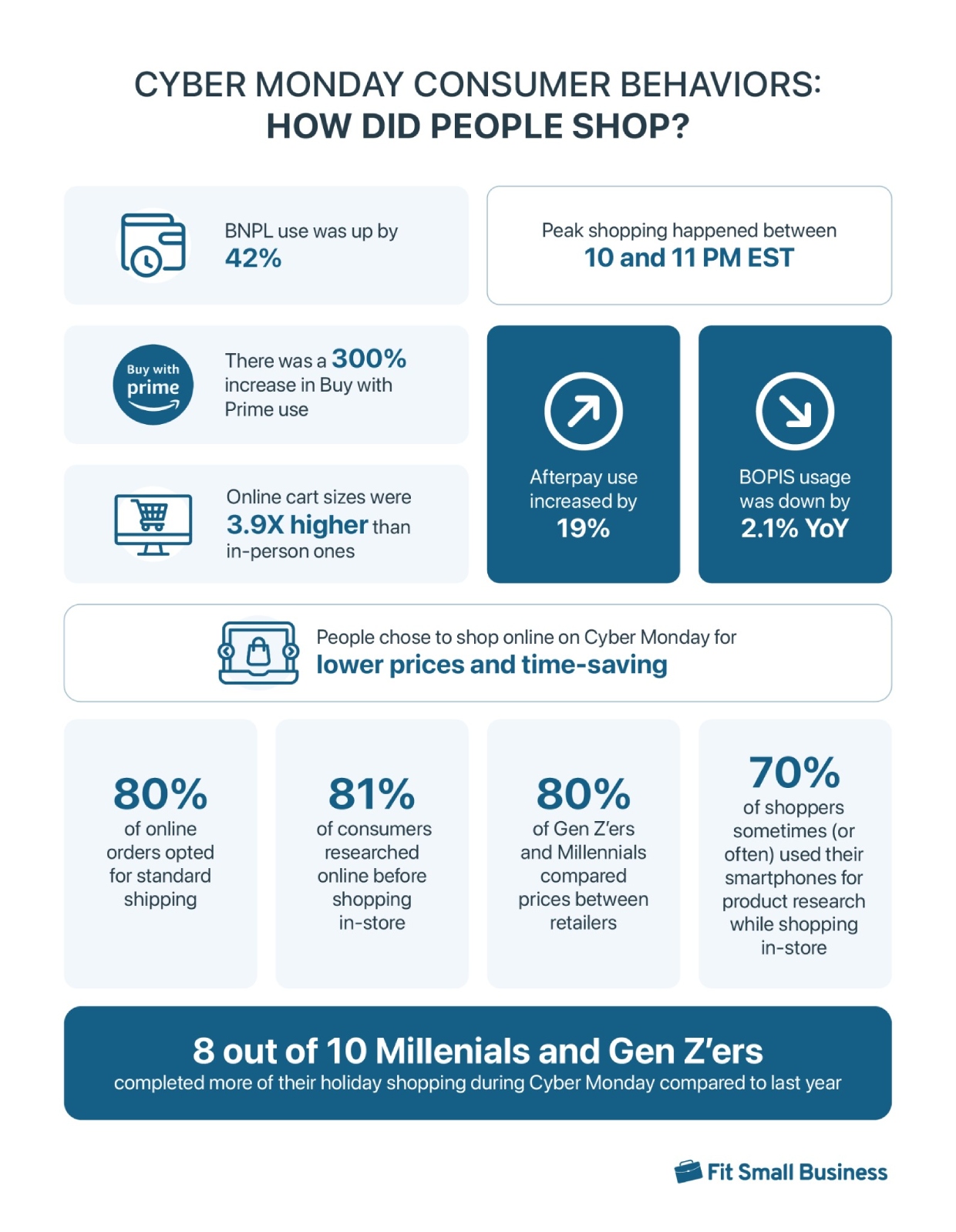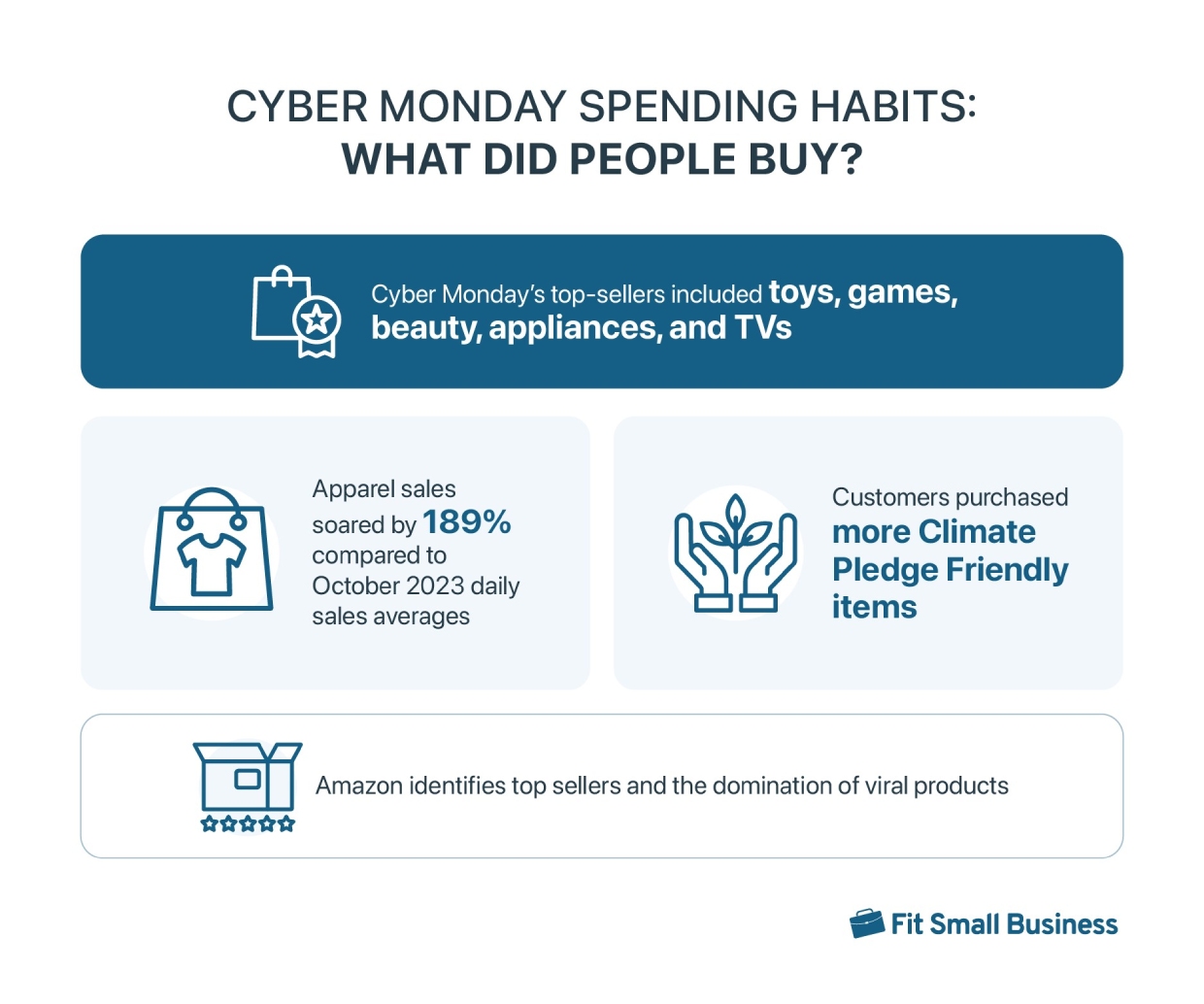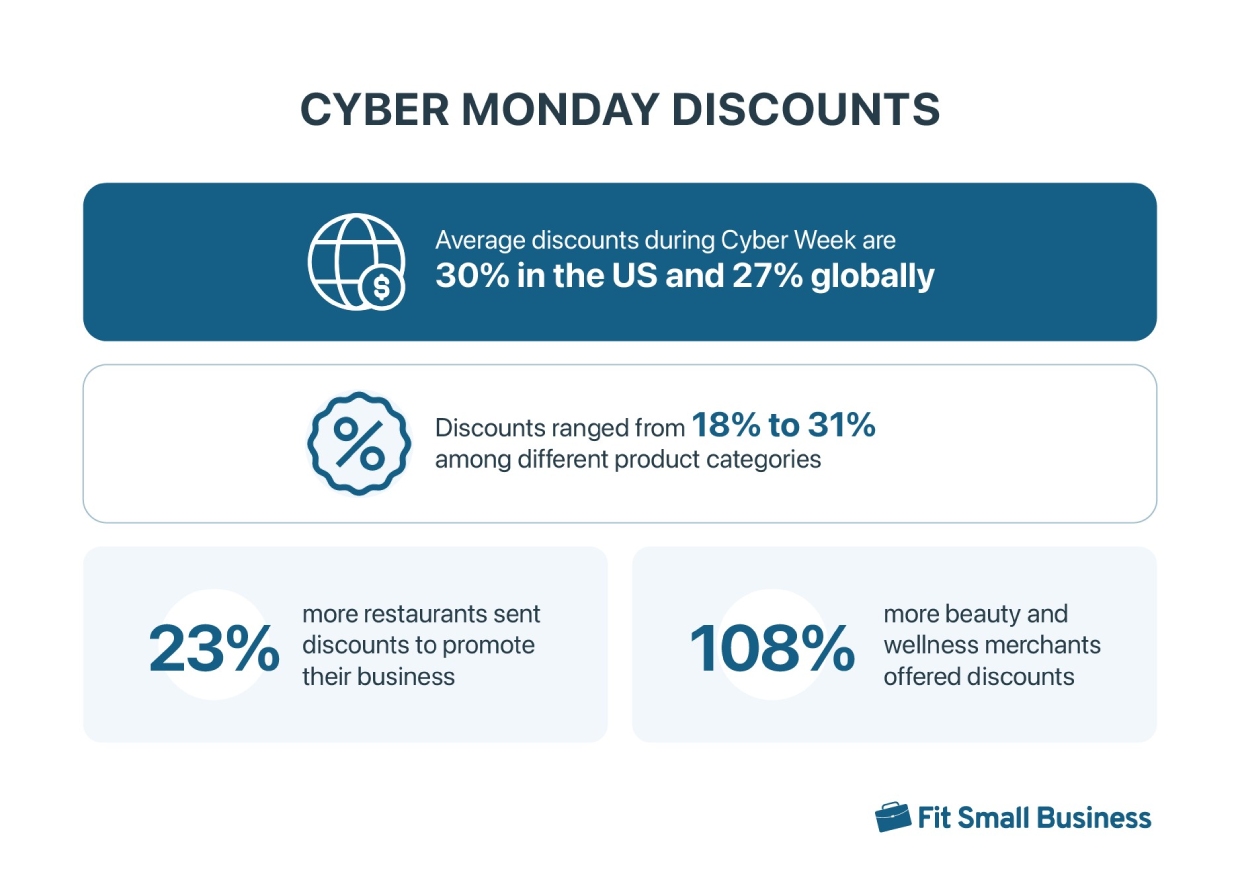Cyber Monday, the ecommerce counterpart to Black Friday, happened Nov. 27, 2023 and saw huge success despite tenuous economic conditions. In this article, we will look at all things Cyber Monday, with 26 statistics covering everything from Cyber Monday stats and trends to sales numbers and fun facts. But before we delve in, here is a look at some of the key takeaways from 2023’s Cyber Monday.
Key Takeaways:
- Cyber Monday 2023 was the biggest online shopping day of all time: Beating out 2022 for the spot by nearly 10%, Cyber Monday 2023 saw the highest single-day ecommerce sales of all time.
- Consumers are resilient: With the economic conditions in mind, experts anticipated a slow Cyber Monday this year. Consumers proved them wrong, however, surpassing expectations and growing nearly 10% in revenue YoY.
- Discounts are growing: Consumers are searching for deals in the current economic conditions and retailers are meeting their demands with higher discounts YoY.
- Customer financing surged: The use of buy now, pay later services like Afterpay and Affirm surged more than 42% YoY driving sales to a new high.
Cyber Monday Sales Numbers
First, let’s take a big-picture approach and see how Cyber Monday did this year based on its sales numbers.

1. Cyber Monday 2023 was the biggest ecommerce shopping day of all time
Cyber Monday is typically the biggest ecommerce shopping day of the year, but this year, Cyber Monday took on a new title: the biggest online shopping day of all time.
2. Americans spent $12.4 billion
This Cyber Monday, Americans spent a total of $12.4 billion, making 2023’s Cyber Monday the biggest to date.
3. Cyber Monday spending increased by 9.6% YoY
Despite uncertain economic conditions, Adobe Analytics data found that Cyber Monday sales grew 9.6% year-over-year (YoY).
4. Cyber Monday 2023 surpassed initial projections by $400 million
An expert analysis from Adobe prior to Cyber Monday anticipated that 2023’s Cyber Monday would hit $12 billion in sales, up 6.1% YoY. As you can see above, this initial prediction was blown out of the water by $400 million.
5. At peak shopping times, $15.7 million was spent every minute
At its peak, Cyber Monday saw $15.7 million in sales every minute.
6. The average cart was valued at $108.12
According to data from Shopify, the average purchase value on Cyber Monday was $108.12.
Cyber Monday Trends: Consumer Behaviors
Consumers were all for Buy Now, Pay Later (BNPL), big online carts, and mid-morning browsing. Let’s take a look at those and other consumer behaviors from this year’s Cyber Monday.

7. BNPL use was up by 42%
Consumers purchased $940 million via Buy Now, Pay Later (BNPL) services like Afterpay, Klarna, and Affirm. This represents a staggering 42.5% increase in BNPL use year-over-year as consumers took advantage of its flexible financing solutions.
8. Peak shopping happened late night
According to data from Adobe Analytics, for this year’s Cyber Monday, spending peaked between 10 p.m. to 11 p.m. Eastern time.
9. There was a 300% increase in Buy with Prime use on Cyber Monday
Amazon recently rolled out a new payment gateway solution for Prime merchants, Buy with Prime. The payment gateway has seen a lot of success already, but on Cyber Monday, it exploded, with a 300% increase in units purchased through Buy with Prime versus the daily average for October 2023.
10. On average, online cart sizes were 3.9x higher than in-person ones
According to data from Square, online cart sizes were much larger than in-person ones on Cyber Monday. In fact, on average, online purchase values were nearly four times as large as in-person ones.
11. Afterpay use increased by 19%
One of the biggest names in the customer financing/BNPL world, Afterpay saw massive YoY success this Cyber Monday. According to data gathered by Square, Buy Now, Pay Later (BNPL) transactions through Afterpay increased by 19% compared to 2022. Additionally, Afterpay’s marketplace app saw a 16% increase in use.
12. BOPIS usage was down by 2.1% YoY
As more shoppers returned to stores and utilized favorable shipping terms for their online orders, the use of buy online, pick up in-store fulfillment fell. Only 12.7% of orders utilized the fulfillment method, down from 14.8% in 2022. This trend seems to indicate that BOPIS will be less of a force as we get farther away from COVID, but it will continue to be an important service to offer convenience for shoppers.
13. Standard shipping dominated as consumers sought free or affordable fulfillment
Eighty percent of online orders opted for standard shipping as shoppers sought our affordable fulfillment options.
14. People choose to shop online on Cyber Monday for lower prices and time-saving
In a survey from Klarna, they asked consumers who planned to shop online for Cyber Monday why they were choosing ecommerce shopping over in-person. In response, 74% of global shoppers said they thought they could get lower prices online and 78% said they prefer online because it takes less time.
15. 81% of consumers researched online before shopping in-store
For the consumers that did enter into store this Cyber Monday, 81% said they sometimes (or often) research online before shopping brick-and-mortar. Of that 81%, 27% said they do pre-research online often.
16. 80% of Gen Zers and millennials compared prices between retailers
Shoppers are becoming more savvy with the influx of information at their fingertips. For younger generations, namely Gen Z and millennials, this meant that 80% of them were price comparing between retailers as they shopped Cyber Monday sales.
17. 8 out of 10 millennials and Gen Z’ers completed more of their holiday shopping during Cyber Monday
In efforts to make holiday purchases when items were discounted, 80% of Gen Z and millennial shoppers said they did more of their holiday shopping Cyber Monday, compared to last year.
18. 70% of shoppers sometimes (or often) used their smartphones for product research while shopping in-store
While in-store shopping used to be a “what you see is what you get” experience, the introduction of smartphones has changed this, allowing for in-store product research and price comparison. In a survey from Klarna, they found that 70% of shoppers sometimes or often used their phones to do in-store research on Cyber Monday.
Cyber Monday Stats on Top-sellers
Here, we will take a look at what people were buying this Cyber Monday and insights into why certain products soared.

19. Cyber Monday’s top-sellers included toys, games, beauty, appliances, and TVs
According to findings from Adobe Analytics, the top sellers this Cyber Monday were toys (Hot Wheels, Mario Kart), games and consuls (Xbox Series X, PlayStation 5, Nintendo Switch, Spiderman 2, Call of Duty: Modern Warfare III), along with skincare gift sets, small kitchen appliances, and televisions.
20. Apparel sales soared by 189% compared to October 2023 daily sales averages
On Cyber Monday, apparel saw a major win, with online sales increasing by 189% compared to an average day in October 2023. Other categories that saw surges in demand on Cyber Monday include appliances (up 166%) and toys (up 140%), furniture (up 129%), electronics (up 103%), jewelry (up 99%), and sporting goods (up 95%).
21. Customers purchased more Climate Pledge Friendly items
Compared to years past, consumers purchased more Climate Pledge Friendly products. This is part of a larger trend in retail where consumers are seeking brands that espouse a brand ethic and stand for causes that are in line with their moral sensibilities.
22. Amazon identifies top sellers and the domination of viral products
Amazon released a breakdown of its 17 best sellers from Cyber Monday and the list is dominated by products that went viral this past year. Many of these products, including COSRX Snail Mucin, Mighty Patches, the Bissel upholstery cleaner, and more all rose to prominence on TikTok and were swooped up by consumers when their prices dropped on Cyber Monday.
Cyber Monday Discount Stats
Every year, people seem to complain more and more about the scarcity of real discounts on Cyber Monday.

23. Average discounts during Cyber Week are 30% in the US and 27% globally
A study from Salesforce found that the average Cyber Week discount rate for US retailers to be 30%, and for global retailers, 27%
24. Discounts ranged from 18% to 31% among different product categories
Adobe Analytics found that Cyber Monday discounts ranged from 18% to 31% depending on the type of product. Electronics saw the highest discounts at 31% (up from 25% in 2022), then toys at 27%, apparel at 23%, furniture at 21%, and appliances at 18%.
25. 23% more restaurants sent discounts to promote their business
It was not just retailers participating in Cyber Monday discounts this year. In efforts to promote their businesses and drive traffic, 23% of restaurants offered Cyber Monday discounts this year.
26. 108% more beauty and wellness merchants offered discounts
Compared to 2022, Square found that 108% more beauty and wellness businesses participated in the Cyber Monday shopping holiday and offered discounts to their clients.
Bottom Line
Cyber Monday was a big day for retailers this year, making the shopping holiday the biggest day ever for ecommerce for another year in a row. There is much to be learned from 2023’s Cyber Monday numbers, from how to appeal to customers to emerging trends in the retail landscape in general. Take these lessons and bring them to your business so you can get ready for next year and make it your best Cyber Monday yet.